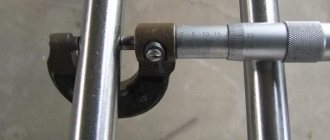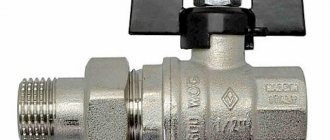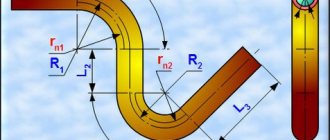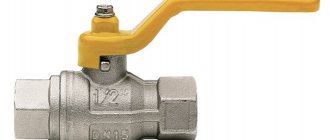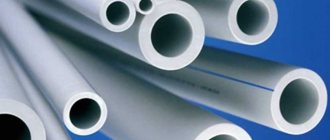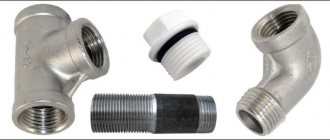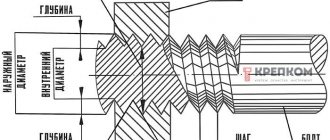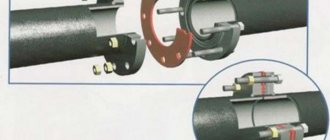Her Majesty the trumpet! Of course, it makes our lives better. Like that:
The key characteristic of any cylindrical pipe is its diameter. It can be internal ( Dу ) and external ( Dn ). Pipe diameter is measured in millimeters, but the unit of pipe thread is inch.
At the junction of the metric and foreign measurement systems, the most questions usually arise.
In addition, the actual size of the internal diameter often does not coincide with Dy .
Let's take a closer look at how we can continue to live with this. A separate article is devoted to pipe threads; click here to read more.
Inches vs mm. Where does the confusion come from and when is a correspondence table needed?
Pipes, the diameter of which is indicated in inches ( 1″, 2″ ) and/or fractions of inches ( 1/2″, 3/4″ ), are a generally accepted standard in water and water gas supply.
What's the difficulty?
Take dimensions from a 1″ (how to measure pipes is described below) and you will get 33.5 mm , which naturally does not coincide with the classic linear conversion table for inches to mm ( 25.4 mm ).
As a rule, the installation of inch pipes proceeds without difficulty, but when replacing them with pipes made of plastic, copper and stainless steel, a problem arises - the discrepancy between the size of the indicated inch ( 33.5 mm ) and its actual size ( 25.4 mm ).
Usually this fact causes bewilderment, but if you look deeper into the processes occurring in the pipe, the logic of the size discrepancy becomes obvious to a layman. It's quite simple - read on.
The fact is that when creating a water flow, the key role is played not by the external, but by the internal diameter, and for this reason it is used for designation.
However, the discrepancy between designated and metric inches still remains, since the internal diameter of the standard pipe is 27.1 mm , and the reinforced one is 25.5 mm . The last value is quite close to the equality 1”=25.4 , but still it is not it.
The solution is that to designate the size of pipes, a nominal diameter rounded to a standard value is used (nominal diameter Dy ). The nominal diameter is selected so that the pipeline capacity increases from 40 to 60% depending on the increase in the index value.
Example:
The outer diameter of the pipe system is 159 mm, the pipe wall thickness is 7 mm. The exact internal diameter will be D = 159 - 7 * 2 = 145 mm. With a wall thickness of 5 mm, the size will be 149 mm. However, in both the first and second cases, the conditional passage will have one nominal size of 150 mm.
In situations with plastic pipes, adapters are used to solve the problem of inappropriate sizes. If it is necessary to replace or connect inch pipes with pipes made according to real metric dimensions - copper, stainless steel, aluminum, both the outer and inner diameters should be taken into account.
Table of nominal diameter in inches
| Du | Inches | Du | Inches | Du | Inches |
| 6 | 1/8″ | 150 | 6″ | 900 | 36″ |
| 8 | 1/4″ | 175 | 7″ | 1000 | 40″ |
| 10 | 3/8″ | 200 | 8″ | 1050 | 42″ |
| 15 | 1/2″ | 225 | 9″ | 1100 | 44″ |
| 20 | 3/4″ | 250 | 10″ | 1200 | 48″ |
| 25 | 1″ | 275 | 11″ | 1300 | 52″ |
| 32 | 1(1/4)» | 300 | 12″ | 1400 | 56″ |
| 40 | 1(1/2)» | 350 | 14″ | 1500 | 60″ |
| 50 | 2″ | 400 | 16″ | 1600 | 64″ |
| 65 | 2(1/2)» | 450 | 18″ | 1700 | 68″ |
| 80 | 3″ | 500 | 20″ | 1800 | 72″ |
| 90 | 3(1/2)» | 600 | 24″ | 1900 | 76″ |
| 100 | 4″ | 700 | 28″ | 2000 | 80″ |
| 125 | 5″ | 800 | 32″ | 2200 | 88″ |
Inner and outer diameters
Table of correspondence between nominal diameter, thread and outer diameters of the pipeline in inches and mm.
| Nominal pipe diameter Dy. mm | Thread diameter G". inch | Pipe outer diameter Dn. mm | ||
| Water/water-gas pipes GOST 3263-75 | Epoxy-welded straight-seam steel pipes GOST 10704-91. Seamless hot-deformed steel pipes GOST 8732-78. GOST 8731-74 (FROM 20 TO 530 ml) | Polymer pipe. PE, PP, PVC | ||
| 10 | 3/8″ | 17 | 16 | 16 |
| 15 | 1/2″ | 21.3 | 20 | 20 |
| 20 | 3/4″ | 26.8 | 26 | 25 |
| 25 | 1″ | 33.5 | 32 | 32 |
| 32 | 1 1/4″ | 42.3 | 42 | 40 |
| 40 | 1 1/2″ | 48 | 45 | 50 |
| 50 | 2″ | 60 | 57 | 63 |
| 65 | 2 1/2″ | 75.5 | 76 | 75 |
| 80 | 3″ | 88.5 | 89 | 90 |
| 90 | 3 1/2″ | 101.3 | ||
| 100 | 4″ | 114 | 108 | 110 |
| 125 | 5″ | 140 | 133 | 125 |
| 150 | 6″ | 165 | 159 | 160 |
| 160 | 6 1/2″ | 180 | 180 | |
| 200 | 219 | 225 | ||
| 225 | 245 | 250 | ||
| 250 | 273 | 280 | ||
| 300 | 325 | 315 | ||
| 400 | 426 | 400 | ||
GOST - state standard used in heat - gas - oil - pipelines
ISO - standard for designating diameters, used in plumbing engineering systems
SMS - Swedish standard for pipe diameters and valves
DIN / EN - the main European standard for steel pipes according to DIN2448 / DIN2458
DN (Dy) - nominal diameter
Tables with sizes of polypropylene pipes are presented in the following article >>>
Compliance of the nominal diameter with international markings
| GOST | ISO inch | ISO mm | SMS mm | DIN mm | DU |
| 8 | 1/8 | 10,30 | 5 | ||
| 10 | 1/4 | 13,70 | 6,35 | 8 | |
| 12 | 3/8 | 17,20 | 9,54 | 12,00 | 10 |
| 18 | 1/2 | 21,30 | 12,70 | 18,00 | 15 |
| 25 | 3/4 | 26,90 | 19,05 | 23(23) | 20 |
| 32 | 1 | 33,70 | 25,00 | 28,00 | 25 |
| 38 | 1 ¼ | 42,40 | 31,75 | 34(35) | 32 |
| 45 | 1 ½ | 48,30 | 38,00 | 40,43 | 40 |
| 57 | 2 | 60,30 | 50,80 | 52,53 | 50 |
| 76 | 2 ½ | 76,10 | 63,50 | 70,00 | 65 |
| 89 | 3 | 88,90 | 76,10 | 84,85 | 80 |
| 108 | 4 | 114,30 | 101,60 | 104,00 | 100 |
| 133 | 5 | 139,70 | 129,00 | 129,00 | 125 |
| 159 | 6 | 168,30 | 154,00 | 154,00 | 150 |
| 219 | 8 | 219,00 | 204,00 | 204,00 | 200 |
| 273 | 10 | 273,00 | 254,00 | 254,00 | 250 |
Diameters and other characteristics of stainless steel pipes
| Passage, mm | diameter , mm | Wall thickness, mm | Weight of 1 m pipe (kg) | |||
| standard | reinforced | standard | reinforced | |||
| 10 | 17 | 2.2 | 2.8 | 0.61 | 0.74 | |
| 15 | 21.3 | 2.8 | 3.2 | 1.28 | 1.43 | |
| 20 | 26.8 | 2.8 | 3.2 | 1.66 | 1.86 | |
| 25 | 33.5 | 3.2 | 4 | 2.39 | 2.91 | |
| 32 | 42.3 | 3.2 | 4 | 3.09 | 3.78 | |
| 40 | 48 | 3.5 | 4 | 3.84 | 4.34 | |
| 50 | 60 | 3.5 | 4.5 | 4.88 | 6.16 | |
| 65 | 75.5 | 4 | 4.5 | 7.05 | 7.88 | |
| 80 | 88.5 | 4 | 4.5 | 8.34 | 9.32 | |
| 100 | 114 | 4.5 | 5 | 12.15 | 13.44 | |
| 125 | 140 | 4.5 | 5.5 | 15.04 | 18.24 | |
| 150 | 165 | 4.5 | 5.5 | 17.81 | 21.63 | |
Did you know?
What ingenious lamps can you assemble with your own hands from an ordinary metal pipe? Anyone can do this! Find out more at the link >>>
Metal products and their outer diameters
All types of metal pipes are manufactured at the factory, based on their outer diameter “Dн”. Standard diameters are shown in the table below.
In industry and construction, they mainly use products whose diameters are in the range of 426–1420 mm. Intermediate standard sizes of water pipes are taken from the table.
Small D metal products are mainly used for laying water pipes in residential buildings.
Medium D metal pipelines are used for laying city water supply. Such water pipes are used by industrial systems involved in the extraction of crude oil.
Large sizes of steel pipelines have found application in the creation and laying of main oil pipelines. They are also used in the gas industry. Through such pipelines gas is supplied to every corner of the planet.
Which pipe is considered small - medium - large?
Even in serious sources I have seen phrases like: “We take any pipe of average diameter and...”, but no one indicates what this average diameter is.
To figure it out, you should first understand what diameter you need to focus on: it can be internal or external. The first is important when calculating the transport capacity of water or gas, and the second is important for determining the ability to withstand mechanical loads.
External diameters:
- From 426 mm is considered large;
- 102-246 is called average;
- 5-102 is classified as small.
As for the internal diameter, it is better to look at the special table (see above).
How to find out the diameter of a pipe? Measure!
For some reason this strange question often comes to e-mail and I decided to supplement the material with a paragraph about measurement.
In most cases, when purchasing, it is enough to look at the label or the seller. But it happens that you need to repair one of the communication systems by replacing pipes, and initially it is not known what diameter the already installed ones have.
There are several ways to determine the diameter, but we will list only the simplest ones:
- Arm yourself with a tape measure or a measuring tape (this is how women measure their waist). Wrap it around the pipe and record the measurement. Now, to obtain the desired characteristic, it is enough to divide the resulting figure by 3.1415 - this is the number Pi.
Example:
Let's imagine that the girth (circumference L) of your pipe is 59.2 mm . L=ΠD, resp. the diameter will be: 59.2 / 3.1415 = 18.85 mm .
- After obtaining the outer diameter, you can find out the inner one. Only for this you need to know the thickness of the walls (if there is a cut, just measure with a tape measure or other device with a millimeter scale).
Let's assume that the wall thickness is 1 mm. This figure is multiplied by 2 (if the thickness is 3 mm, then it is also multiplied by 2 in any case) and subtracted from the outer diameter (18.85- (2 x 1 mm) = 16.85 mm) .
It’s great if you have a caliper at home. The pipe is simply grabbed by the measuring teeth. We look at the required value on a double scale.
Types of steel pipes according to their production method
- Electric welded (straight seam)
For their manufacture, strips or sheet steel are used, which are bent to the required diameter using special equipment, and then the ends are connected by welding.
The effect of electric welding guarantees a minimum seam width, which makes it possible to use them for the construction of gas or water pipelines. The metal is in most cases carbon or low alloy.
The indicators of finished products are regulated by the following documents: GOST 10704-91, GOST 10705-80 GOST 10706-76 .
Please note that a pipe manufactured in accordance with standard 10706-26 is distinguished by the maximum strength among its peers - after creating the first connecting seam, it is reinforced with four additional ones (2 inside and 2 outside).
The regulatory documentation indicates the diameters of products produced by electric welding. Their size ranges from 10 to 1420 mm.
- Spiral seam
The material for production is steel in rolls. The product is also characterized by the presence of a seam, but unlike the previous production method, it is wider, which means the ability to withstand high internal pressure is lower. Therefore, they are not used for the construction of gas pipeline systems.
A specific type of pipe is regulated by GOST number 8696-74.
- Seamless
The production of a specific type involves the deformation of specially prepared steel blanks. The deformation process can be carried out both under the influence of high temperatures and in a cold way (GOST 8732-78, 8731-74 and GOST 8734-75, respectively).
The absence of a seam has a positive effect on the strength characteristics - the internal pressure is evenly distributed over the walls (there are no “weak” places).
As for diameters, standards control their production with a value of up to 250 mm. When purchasing products with sizes exceeding those indicated, you have to rely only on the integrity of the manufacturer.
It is important to know!
If you want to buy the most durable material, buy seamless cold-formed pipes. The absence of temperature influences has a positive effect on preserving the original characteristics of the metal.
Also, if the ability to withstand internal pressure is an important indicator, then choose round products. Profile pipes cope better with mechanical loads (metal frames, etc., are well made from them).
Here are a couple more excellent slides of creative advertising for a pipe manufacturer:
Plastic
Nowadays, their plastic counterparts have become an alternative to metal pipes. Moreover, their sizes vary widely. The material for such a product is:
- Polypropylene;
- Polyethylene;
- Metal-plastic.
Each manufacturer of such pipes sets its own size chart. Therefore, if one system is being manufactured, it is advisable to use parts from the same manufacturer.
Of course, there will definitely be discrepancies, but they will be minimal and will not cause any particular difficulties for a good master. If a person has little experience, he will have to make some efforts to fit all the sizes.
The table of sizes of plastic pipes for water supply using polypropylene of various densities shows the most popular models.
When all kinds of communications are laid, builders also use other diameters of plastic water pipes.
The diameters of water pipes in the table help you select the appropriate product for repairs or other work.
